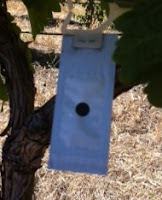As I sit here typing, it's just started to rain in Livermore. It's June 28th...Summer...warm growing area...and it's freakin' raining. Looking at the Mercury News website today, and it notes that the1/4" of rain expected in the South Bay on June 28 may be a "once-in-a-lifetime" experience for people. I don't want any more experiences like that.
Anyway, this post is not about the challenges of weather, which are ubiquitous and ever-present for farmers; it is about the pests that can ravage a vineyard, taking an investment worth millions of dollars and slowly strangling it.
Leaf Roll virus is becoming a major problem in California vineyards again. Transmitted by a couple different types of mealy bug which can live under the outer layers of the trunks of vines, Leaf Roll turns the leaves red later in the growing season thereby interfering with photosynthesis and the ripening of fruit. Once a vineyard is infected, there is no cure expect pulling the vineyard out and replanting. When one considers that it can cost more than $30,000 per acre to plant a vineyard and experts advise leaving an infected vineyard fallow for up to 10 years after an infestation, the presence of these bugs and their viruses can be devastating.
There are only a few things that can be done to slow the spread of the pests and most are of a prophylactic nature: making sure that equipment that is used in one vineyard is thoroughly cleaned before it is used in yours; making sure you have completely virus-free vines going into your site, etc. Another method currently being employed in the vineyard uses pheremones of female mealy bugs to make it more difficult for the male of the species to find the female. The tag is affixed to every tenth vine or so and has shown promise in our own vineyards.








